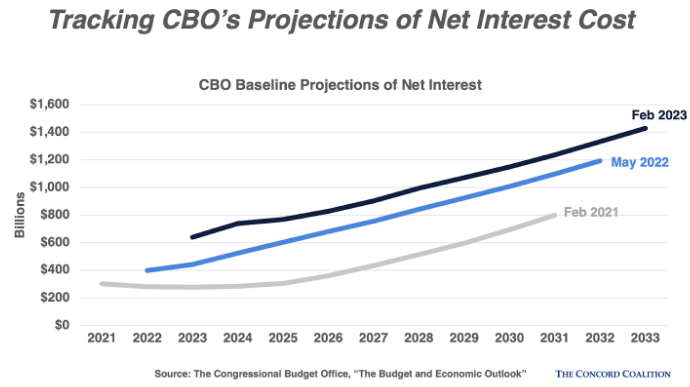WASHINGTON, DC – Today, the nonpartisan Congressional Budget Office (CBO) released its latest projections for the federal budget and the U.S. economy, providing yet another reminder of the unsustainable trajectory of the federal budget. According to The Concord Coalition, CBO’s new projections demonstrate that the expressed desire of many political leaders to reduce the budget deficit or even balance the budget is fundamentally at odds with their equally expressed desire to exempt popular programs from spending cuts or refuse to consider higher revenues.
“The post-COVID dividend has run its course. After a steep decline in deficits following the expiration of emergency measures enacted to provide COVID relief, the budget has resumed a pre-existing pattern of escalating deficits that reflects a long-standing built-in mismatch between spending promises and projected revenues,” said Bob Bixby, Executive Director of The Concord Coalition. “Pretending that this pattern can be altered without touching popular programs such as Medicare, Social Security, and defense, which comprise 48 percent of the budget, or without bringing in more revenues, is a conscious decision to ignore the obvious. Hard choices must be made to put the budget on a path of fiscal sustainability.”
After nearly two decades of record low interest rates, persistent inflation has led to rising interest rates that will translate into higher interest costs as the Treasury Department rolls over the securities needed to refinance the national debt. CBO’s latest projections show net interest payments will cost $11.1 trillion over the next ten years, compared to $8.1 trillion in last year’s report. By 2028, net interest costs exceed all spending on defense in CBO’s projections.

It is also important to note that CBO’s latest projections include a portion of the Biden Administration’s student loan forgiveness initiatives, excluding the potentially most expensive element: a proposed regulation regarding a new income-related repayment plan.
Finally, CBO projects both Medicare Part A (2033) and Social Security (2033) will become insolvent within the next ten years. Under current law, the exhaustion of the trust funds will force the programs to operate on a pay-as-you-go basis, thereby delaying payments to beneficiaries and providers, effectively reducing them by 15% and 22%, respectively. Although it’s a standard baseline procedure to assume payments will be made in full and on time despite the insolvency of the trust funds, this assumption is misleading. Policymakers and the public should understand that doing nothing to address insolvency will result in automatic benefits cuts.




